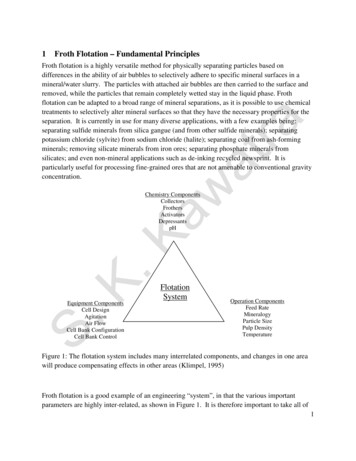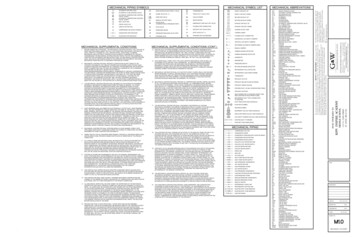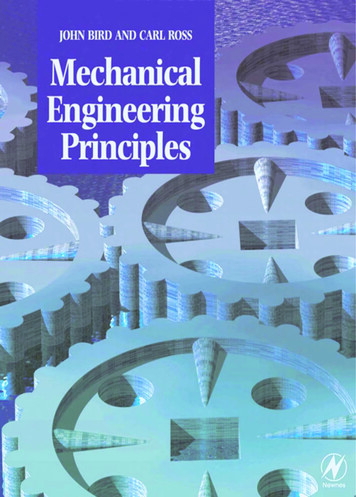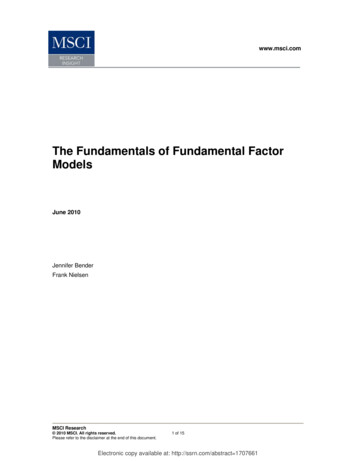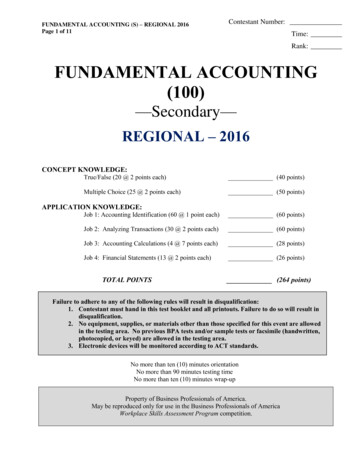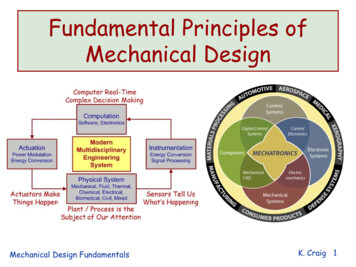
Transcription
Fundamental Principles ofMechanical DesignMechanical Design FundamentalsK. Craig 1
References Precision Machine Design, A. Slocum, 1992. Exact Constraint Design: Machine Design Using KinematicPrinciples, D. Blanding, 1999. The Elements of Mechanical Design, J. Skakoon, 2008. Design Principles for Precision Mechanisms, H. Soemers, 2010. Mechanical Engineering Design, J. Shigley and C. Mischke, 5thEdition, 1989. Detailed Mechanical Design: A Practical Guide, J. Skakoon, 2000. Fundamentals of Design, A. Slocum, 2007. Universal Principles of Design, W. Lidwell, K. Holden, & J. Butler,2003. Mechatronics and Machine Design Notes, S. Awtar, U. Michigan.Mechanical Design FundamentalsK. Craig 2
Introduction Precision machines are essential elements of an industrialsociety. A precision machine is an integrated system that relies onthe attributes of one component to augment theweaknesses of another component. Here we emphasize the design of mechanical and structuralprecision machine components and their integration withsensor, actuator, and control systems to maximizeperformance. Design is a mixture of analysis and creative thought. Good designs are based on excellent concepts and properlydesigned details.Mechanical Design FundamentalsK. Craig 3
Design engineers must be more creative than theircompetition and more observant of the world around them. Analogous to physical exercise, analysis is a form of mentalexercise that trains the mind to be strong and swift. Manydesigns would never have even been conceived of if thedesign engineer did not understand the basic physicsbehind the process or machine that prompted the need for anew design. Design engineers must be good at identifying problems.Once a problem is identified, it will usually yield to anunending barrage of creative thought and analysis. In addition to identifying and solving problems, the designengineer must also learn to identify what the customer reallyneeds, which is not necessarily what the customer thinksthat he or she needs.Mechanical Design FundamentalsK. Craig 4
Fundamental Principles Understand them. Associate images with them. When you look at a machine or structure, try to seethe fundamental principles in either action ormissing. With a deep knowledge of these fundamentalprinciples, one can rapidly generate strategies andconcepts with the greatest viability. With a deep understanding of fundamentalprinciples, one can critically evaluate othermachines and components.Mechanical Design FundamentalsK. Craig 5
Occam’s Razor– Keep things simple to start and add detail as the designdevelops. Simplicity vs. Complexity– Create designs that are explicitly simple. Keepcomplexity intrinsic. Laws of Nature– Fundamental Laws of Nature – the basics come beforethe details!– Newton’s Laws, Laws of Thermodynamics, Maxwell’sEquations Saint-Venant’s Principle– When an object is to be controlled, sketch it being heldat points several characteristic dimensions apart.Mechanical Design FundamentalsK. Craig 6
Golden Rectangle– Don’t know what size it should be? Start with a ratio ofabout 1.6:1. Independent Functions Keep the functions of a design independent from oneanother. Abbe’s Principle– Small angular deflections are amplified by distance tocreate large linear displacements. Maxwell & Reciprocity– Uncomfortable with a design? Try inverting it, or turningit on its side.Mechanical Design FundamentalsK. Craig 7
Self-Principles– Use an object’s geometry or other property to prevent aproblem. Stability– Stable, neutrally stable, and unstable effects can help orhurt. Some things can be made neutrally stable andfast, while vibration can induce instability. Beware ofbuckling of compression members. Symmetry– Try a design that is symmetric, and then imposereciprocity to consider a design that is not symmetric. Parallel Axis Theorem– Add mass away from the neutral axis to increasestrength and stiffness.Mechanical Design FundamentalsK. Craig 8
Accuracy, Repeatability, and Resolution– Make your machine repeatable first, then tune foraccuracy if you have fine enough resolution. Tell thesame story each time, the correct story, and withenough detail so people can understand it. Sensitive Directions and Reference Features– Why pay for performance in a direction that is notneeded? Establish reference datums from which youmeasure critical parameters. Triangulate for Stiffness– Triangulate parts and structures to make them stiffer.Mechanical Design FundamentalsK. Craig 9
Load Paths– Plan the load paths in parts, structures, and assemblies.– Draw a line through the path that forces follow, and seekto minimize its length. If the path and shape changessignificantly as the machine moves, then the machine willhave limited accuracy and may have limited repeatability. Avoid Bending Stresses– Prefer tension and compression. Manage Friction– Avoid sliding friction. Use rolling element bearings. Free Body Diagrams & Superposition– To analyze a complex object, separate it into parts andlabel the forces and moments on each part that areimposed by other parts.Mechanical Design FundamentalsK. Craig 10
Preload– Loose fits between objects mean you cannot predictwhere one object will be with respect to the other.Apply loads between the objects as part ofmanufacturing and assembly to take out the slack inthe system. Centers of Action– If forces are applied through the centers of mass,stiffness, and friction, there will be no moments andhence minimal errors. Exact Constraint Design– The number of points at which a body is held orsupported should be equal to the number of degreesof freedom that are to be constrained.Mechanical Design FundamentalsK. Craig 11
Elastically Averaged Design– Hold or support a body with ten times (or more)compliant points than there are degrees of freedom tobe restrained, such that the errors in the compliantsupport points will average out. Stick Figures– Initially sketch an idea using simple stick figures,which also denote where major coordinate systemsare located in the design. The coordinate systemsare to be used for modeling individual modules, e.g.,for creating an error budget to predict a machine’srepeatability and accuracy.Let’s discuss these in more detail!Mechanical Design FundamentalsK. Craig 12
Occam’s Razor William of Occam (1284-1347) – English philosopherand theologian “Plurality should not be assumed without necessity.” A problem should be stated in in its most basic andsimplest terms. The simplest theory that fits the facts of a problem is theone that should be selected. Limit Analysis should be used to check ideas. Use fundamental principles as catalysts to help keepthings simple.Mechanical Design FundamentalsK. Craig 13
Complexity is to be minimized in both design andmanufacturing. A careful systems approach is required. Opportunities to Keep Things Simple– Overall Design Strategy– Design Concept– Formation of Modules Modules have to be assembled and interfaced toeach other.– Design and Selection of Components Detailed design gets done at the component level. Keep functional requirements of the design inmind. Keep implied functional requirements of thecomponents in mind.Mechanical Design FundamentalsK. Craig 14
– Goal is to minimize the number of components (whichmay lead to the specification of a few highly complexcomponents) and balance component complexity withthe number and complexity of the manufacturingprocesses and the quantity to be manufactured.Mechanical Design FundamentalsK. Craig 15
Simplicity vs. Complexity Create designs that are explicitly simple. Keepcomplexity intrinsic. What makes a design simple? Can your intuition alonejudge simplicity? Will you know it when you see it? The less thought and less knowledge a device requiresfor production, testing, and use, the simpler it is. How much thought? How much knowledge? Judge bestby comparing one solution to another. Of course, it may take lots of thought and knowledge toget to a design requiring little of either – that is design!Mechanical Design FundamentalsK. Craig 16
What a simple design means is that everyone involvedwith its production and use sees nothing that lookscomplicated from his or her own perspective orconvention. Complexity is buried and invisible. There is a heirarchyfor knowledge and thought. Each hierarchical level maybe intrinsically complex, yet the device remains simple ifthe complexity resides only within its own level.– Screw threads have abundant scientific andmanufacturing complexity, yet that complexity isinvisible to the designer. We just say ¼ -20. Complex geometry no longer implies a complicateddesign. A part’s geometry may be complicated, yet itsproduction and use may be no more difficult than for onewith much simpler geometry.Mechanical Design FundamentalsK. Craig 17
Simplicity can be subtle. Design symmetry intocomponents. If a part is asymmetric, knowledge andthought are needed to orient it for either the assembly orthe use. Assembling or using symmetrical parts requiresless knowledge and thought than asymmetric parts. Simplicity can be paradoxical. Symmetry addsinformation to the component part, thus adding cost tomanufacture, but makes the part simpler to use e.g., thedouble-sided key. Two common techniques for keeping things simple bykeeping complexity hidden are:– Purchasing rather than making components– Specifying components by standardsMechanical Design FundamentalsK. Craig 18
Mechanical Design FundamentalsK. Craig 19
Laws of Nature To develop a physical model of an existing system or ofa system concept, we use engineering judgment andmake simplifying assumptions. To develop a mathematical model, a model that canpredict system dynamic behavior, we apply the Laws ofNature to the physical model. Drop a strong cylindrical magnet down a copper pipewith plenty of clearance between the magnet and thepipe wall. What happens? How many Laws of Natureare illustrated?– Newton’s 2nd Law, Newton’s Law of Gravitation,Ampere’s Law, Faraday’s Law, Lenz’s LawMechanical Design FundamentalsK. Craig 20
Mechanical Design FundamentalsK. Craig 21
Saint-Venant’s Principle Saint-Venant was a strong proponent of coordinatingexperimental and practical work with theoretical study. Hisgreatest contribution to engineering is his approach tomodeling practical problems. The principle says that several characteristic dimensionsaway from an effect, the effect is essentially dissipated. Or ifan effect is to dominate a system, it must be applied over 3-5characteristic dimensions of the system.– Local effects of loading do not effect global strains.– For example, the bending strains at the root of a cantileverbeam are not influenced by the local deformations of apoint load applied to the end of a cantilever beam.Mechanical Design FundamentalsK. Craig 22
Saint-Venant’s Principle 3Mechanical Design FundamentalsφK. Craig 23
The engineering applications of this observation areprofound for the development of conceptual ideas and initiallayouts of designs.– To not feel something’s effects, be several characteristicdimensions away.– To dominate and control something, apply constraintsover several characteristic dimensions. Application of Saint-Venant’s Principle– When mounting bearings to support a shaft, the bearingsshould be spaced 3-5 shaft diameters apart if thebearings are to effectively resist moments applied to theshaft.Mechanical Design FundamentalsK. Craig 24
– In machine tool structure, if one is to minimizebending, the length of the structure should be nomore than 3-5 times the depth of the beam.– When bolting components together, in order to makethe bolted joint act almost as it were welded together,the bolts’ strain (stress) cones should overlap. Thestrain cone emanates from 45 to 60 under the bolthead. The strain cones typically overlap if the boltsare spaced less than 3-5 bolt diameters apart.Mechanical Design FundamentalsK. Craig 25
Golden Rectangle The Golden Rectangle, discovered by Pythagoras, is arectangle whose sides are in proportion such that when asquare is cut from the rectangle, the remaining rectanglehas the same proportions as the original rectangle, i.e., a/b 1.618 If the pattern of subtracting squares continues and a spiralcurve is drawn by linking together circular arcs whosecenters are the corners of the squares, the spiral continuesto infinity.Mechanical Design FundamentalsK. Craig 26
The Golden Rectangle can help the engineer initiallysketch concepts that have a greater chance of beingrealizable. When designing a machine, one can either:– start from the outside and work inwards, which mightforce the inner workings to be cramped and lead todegradation of performance, or– start from the inside with a critical module and designoutwards, which might result in a machine that is toospacious. A compromise from the beginning can be achieved witheither method by initially sketching concepts whilekeeping the proportions of the Golden Rectangle inmind. Saint-Venant’s principle should also beconsidered when laying out proportions and spacing ofmachine elements.Mechanical Design FundamentalsK. Craig 27
Independent Functions Keep the functions of a design independent from oneanother. During the concept development stage of the designprocess, you will decompose a device or system intobasic functions. Keep those functions separate! This is not as easy as it sounds. There willbe temptations to combine functions andfeatures and thus compromise the design.Consider the ball-and-socket tripodhead for a camera. There is nofunctional independence of positioningand locking.Mechanical Design FundamentalsK. Craig 28
This is an improvement in separatingfunctions. Here tightening the nutcreates no rotational friction betweennut and ball, but at a cost inmanufacturing.Multi-axis pan head camera mount hasfunctional independence of all threerotational locking and positioningfunctions.Mechanical Design FundamentalsK. Craig 29
Accept that everything in design, including independenceof function, is a compromise. You need not take anunyielding posture to any rule of design, but alwaysunderstand how and why you yield.Seek independence of thefunctions of a device, butdo not preclude combiningfunctions within parts.Here, the handles areused for two functions,positioning and locking.Combined adjustment andlocking functionalityreduces part count andoperates intuitively.Mechanical Design FundamentalsK. Craig 30
Abbe’s Principle The amplification of angular motion to create largetranslational motions is one of the foremost principles inthe design of precision and robust machines. The Abbe Principle (Dr. Ernst Abbe 1840-1905) resultedfrom observations about measurement errors in themanufacture of microscopes.– If errors in parallax are to be avoided, then themeasuring system must be placed coaxially with theaxis along which the displacement is to be measuredon the workpiece.Mechanical Design FundamentalsK. Craig 31
When an angular error is amplified by a distance, e.g., tocreate an error in a machine’s position, the strictdefinition of the error is a sine or cosine error. The implications of this observation on the design ofinstruments and machines are profound:– Always try to place the measurement system as closeto the line of action (the process) as possible.– Always try to place bearings and actuators as close tothe line of action (the process) as possible.Mechanical Design FundamentalsK. Craig 32
The philosophy of Abbe’s Principle also extends to othertypes of measurements.– When measuring temperature, it is important to placethe temperature sensor as close as possible to theprocess to be measured.– The idea is the same for pressure, flow, voltage,current, etc.– In each case, the farther away you are from theprocess to be measured, the greater the chance forerrors to reduce the accuracy of the measurement. Note that a small angular deflection in one part of amachine quickly grows as subsequent layers of amachine are stacked upon it.Mechanical Design FundamentalsK. Craig 33
Mechanical Design FundamentalsK. Craig 34
Maxwell & Reciprocity James Clerk Maxwell’s (1831-1879) theory of reciprocityis commonly applied to mechanics and precisionmeasurement systems, and philosophically to howdifficult problems can be creatively solved. Let A and B be any two points of an elastic system. Letthe displacement of point B in any direction U due to aforce P acting in any direction V at A be u. Let thedisplacement of A in the direction of V due to a force Q inthe direction U at B be v. Then Pv Qu.ReversalCritical Thinking1 opportunityproblemMechanical Design FundamentalsK. Craig 35
Self Principles Self principles utilize the phenomena the machine is tryingto control to help control the phenomena. There are four basic types of self principles: self-help, selfbalancing, self-protecting, and self-checking. Self-Help Systems– Self-help systems use the phenomena to be controlledas a means for controlling the phenomena. For example,some airplane door mechanisms swing the door outwhen opened, yet the door acts as a self-sealing taperedplug when closed. The modern tubeless tire is a result ofcareful structural design that utilizes the elastic nature ofthe tire to make a seal that allows the tire to be inflated.Mechanical Design FundamentalsK. Craig 36
– Forces applied to a structure or mechanism are usedto great advantage when they: Create new, useful forces Transform or redirect themselves Balance either themselves or existing loads Help to distribute loads– Self-help that Creates Forces Pressure-formed seals such as O-rings andinternally-mounted doors use self-help to createrobust seals. The capstan and windlass use self-help to pull inboat anchors by creating and multiplying frictionthrough several turns of chain.Mechanical Design FundamentalsK. Craig 37
– Self-help that Redirects Forces Left-handed scissors have little to do with howthumb and fingers fit, and lots to do with how handaction naturally forces the blades’ cutting edgestogether. Left- and right-handed scissors are mirror imagesof each other, improving the scissors’ shearingaction for either user.Self-Help in ScissorsMechanical Design FundamentalsK. Craig 38
– Self-help that Balances Forces Self-help can balance or neutralize, at leastpartially, an undesirable effect, e.g.,counterweights on draw and lift bridges and incable-operated elevators.A balanced door with an articulatedhinge exhibits self-help. Wind willnot open this door, yet it opens andcloses easily in strong winds.The hinge point, rather than being atan outer edge, is inboard when thedoor is closed. Wind pressure on thedoor face is balanced on either sideof the hinge axis. As the door opens,the pivot axis slides by mechanicalaction to the side to open the doorfully.Mechanical Design FundamentalsK. Craig 39
– Self-help that Distributes Loads In this case, the load path changes withdeformation, thereby improving performance. In Hertzian contact stress, the larger the load, thelarger the contact area. Structures can also be designed to stiffen orstrengthen with deflection. For example, beamsbecome much stiffer with large deflections (if theydon’t yield) as the bending progresses to tension.Mechanical Design FundamentalsK. Craig 40
Self-Balancing Systems– Self-balancing systems utilize geometry to reduce anundesirable effect such as high stress.– An example of this is the leaning of turbine blades.As the turbine spins, the shape of the blade pumps airthrough the turbine and creates large bendingstresses on the blade. If the blade is tilted so that itslength axis is not along a radius of the turbine,centrifugal forces can be used to create a bendingmoment opposite to that caused by the airflow. In thismanner, cyclic tensile stresses can be minimized.Mechanical Design FundamentalsK. Craig 41
Self-Protecting Systems– Self-protecting systems utilize passive elements toensure that the system is not overloaded to the pointof permanent deformation. They do this by providingadditional force transmission paths after apredetermined elastic deformation occurs.– However, in protecting one component the designengineer must make sure that the effect does notripple through the system and damage othercomponents.– Usually, self-protected systems can return to theirnormal operating range unaffected by overloads.– The most common example of self-protecting systemsare found in spring-actuated mechanisms.Mechanical Design FundamentalsK. Craig 42
Self-Checking Systems– Self-checking systems utilize the concept of symmetryto ensure geometric accuracy. This involves turningthe device through 180 and comparing themeasurements to the first set.– For example, if a coordinate measuring machine(CMM) is very repeatable but not accurate, it can stillbe used to measure the straightness of astraightedge. The edge of the straightedge is placedvertical so that gravity does not create an error. Thestraightedge is measured with the CMM and then thestraightedge is rotated 180 and measured again.The measurements are subtracted from each other,which cancels out the straightness error in the CMM.Mechanical Design FundamentalsK. Craig 43
Stability Stability is of utmost importance in the design of structures,actuators, bearings, and control systems. All systems are either stable, marginally stable, or unstable.Mechanical Design FundamentalsK. Craig 44
Symmetry Can symmetry help or hurt a design? In general, symmetry is a good thing in a system, and thus agood starting point in a design. Symmetry is a principle that is closely related to stability.Symmetry can sometimes provide stability, sometimes not. In structures, symmetry may exist on an overall scale, suchas between two sides of a machine, but within each side ofthe machine, symmetry takes second place to the desiredformation of triangles so as to make a system well-bracedand resistant to shearing. Structures are often symmetric to take loads from either side.Mechanical Design FundamentalsK. Craig 45
In bearings, it is often the opposite, where on an overallscale one side of the system has bearings configuredand mounted to restrain five degrees of freedom of ashaft, and at the other end of the shaft, the bearings onlyprevent radial motion of the shaft. List what is symmetric and what is not symmetric abouteach potential concept. Ask if symmetry helps or hurts.Study what would happen if what was symmetric wasmade non symmetric, and vice versa.Mechanical Design FundamentalsK. Craig 46
Parallel Axis Theorem The Parallel Axis Theorem is a very powerful tool forcalculating the area moments of inertia for complexobjects.– Starting with basic shapes, whose areas and areamoments of inertia about their local neutral axes areknown, a design engineer first finds the location of theneutral axis of the composite structure, and then usesthe parallel axis theorem to determine the areamoment of inertia for the composite structure.Mechanical Design FundamentalsK. Craig 47
Accuracy, Precision, & Resolution A good machine designer understands and hasdeveloped an intuitive feeling for the factors that affectmachine performance. Equally important, the designengineer must also understand the basic physics thatcharacterize a machine component or system. Thisknowledge is essential for the development of gooddesigns and the proper selection of components. The design of quality precision machines dependsprimarily on the ability of the design and manufacturingengineers to predict how the machine will perform beforeit is built.Mechanical Design FundamentalsK. Craig 48
The most important factors affecting the quality of amachine are the accuracy, precision (repeatability), andresolution of its components and the manner in which theyare combined. These factors are critical because theyaffect every one of the parts that will be manufacturedusing the machine. Minimizing machine cost and maximizing machine qualitymandate predictability of accuracy, repeatability, andresolution. This allows the design engineer to optimize thechoice of components and to specify manufacturingtolerances. Designing a machine that has good accuracy, repeatability,and resolution is not a black art. It appears to be a blackart only when the observer lacks the time or resources touse scientific principles to discover the true nature of thephenomena.Mechanical Design FundamentalsK. Craig 49
In the context of taking a deterministic approach todesign, it is very important to understand the rules of thegame. There are three basic definitions to rememberwith respect to how well a machine tool can position itsaxes: accuracy, precision (repeatability), and resolution. The diagram on the next slide represents theseconcepts. Accuracy is the ability to tell the truth. Precision is the ability to tell the samestory over and over again. Resolution is how detailed your story is. These three concepts are often improperly used, solet’s discuss them.Mechanical Design FundamentalsK. Craig 50
Accuracy, Precision (repeatability), and ResolutionMarksman’s TargetMechanical Design FundamentalsK. Craig 51
Accuracy is the ability of system to tell the truth.– Accuracy is a measure of how well a system canachieve or measure a state that is traceable to anational or international standard.– If one were to use a device to make multiplemeasurements of a known standard, the differencebetween the known measurement and the average ofall measurements taken is the accuracy of themeasurement.– Accuracy is the maximum translational or rotationalerror between any two points in the machine’s workvolume.– Accuracy can be represented as the differencebetween the root mean square radius of all the bulletholes in a target and the radius of the bull’s eye.Mechanical Design FundamentalsK. Craig 52
– Linear, planar, and volumetric accuracy can all besimilarly defined for a machine.– Accuracy is affected by the shape and size ofcomponents, as well as thermal growth, backlash,wear, friction, deformations, and sensor and controlsystem accuracy.Mechanical Design FundamentalsK. Craig 53
Repeatability (precision) is the ability to tell thesame story over and over again.– Repeatability tells how well a system can achieve ormeasure the same state each time.– Repeatability is the error between a number of successiveattempts to move the machine to the same position.– If one were to use a device and make multiplemeasurements of a known standard, the standarddeviation of the measurements would be the repeatabilityof the measurement, and the number of standarddeviations would give a confidence level about therepeatability.– Repeatability is affected by thermal growth, backlash,wear, friction, deformations, and sensor and controlsystem repeatability.Mechanical Design FundamentalsK. Craig 54
– Repeatability can be represented by the diameter ofthe circle which contains N% of the bullet holes in thetarget.– Bidirectional repeatability is the repeatability achievedwhen the point is approached from two differentdirections.– For a set of N data points with a normal (Gaussian)distribution the mean xmean and standard deviation σare defined as:1 N1 N2x meanxi σ( x i x mean ) N i 1 N 1 i 1 – The standard deviation is used in the determination ofthe probability of occurrence of an event in a systemthat has a normal distribution.Mechanical Design FundamentalsK. Craig 55
– The percent chance of a valueoccurring within a number ofstandard deviations k of itsexpected value is given in the table.– The probabilistic approach to aproblem is only a tool to allow us todeal with variables that are toonumerous or expensive to sort outproperly by common sense andgood metrology. Required use ofthis tool might be an indication thatit is time to take a closer look at thesystem and see if the system canbe changed to make it deterministicand therefore more controllable.Mechanical Design 730099.993799.9999100.0000K. Craig 56
– Often the key to repeatability is not within themachine itself, but in isolating the machine fromvariations in the environment.Mechanical Design FundamentalsK. Craig 57
Resolution is how detailed your story is.– Resolution is the ability of a system to tell the fine detailsof the story or what is the minimum increment that can bedetected or moved.– If one were to try and move to a desired position, andthen measure the error, and then correct the position bythe smallest achievable amount, it would be limited by theresolution of the system.– Resolution is the larger of the smallest programmablestep or the smallest mechanical step the machine canmake during point-to-point motion.– Resolution is important because it gives a lower bound onthe repeatability that one could obtain if one really tried.– Resolution is affected by friction and also the resolution ofthe measurement and control system.Mechanical Design FundamentalsK. Craig 58
General Comments– Of primary concern is the certainty of themeasurements themselves used to characterize theaccuracy, precision, and resolution of a machine, andwhat parameters these measurements themselvesare functions of.– Classify each of the motions your concepts require interms of the required accuracy, repeatability, andresolution.– How can the concepts be optimized to minimizerequired accuracy and instead rely more onrepeatability?– Can you minimize friction so as to likely increaseresolution?Mechanical Design FundamentalsK. Craig 59
Accuracy, Repeatability, & Resolution Mapping– Mapping is the ability to measure or predict therepeatability or accuracy of a machine, and then usethis
Mechanical Design Fundamentals K. Craig 5 Fundamental Principles Understand them. Associate images with th

